Search for articles or browse our knowledge portal by topic.
Division of Highway Design
The Division of Highway Design, in conjunction with District Design Offices, carries out roadway design activities associated with projects listed in KYTC’s Six-Year Highway Plan (6YP). This article refers to these projects as 6YP Projects. The Division of Highway Design is primarily responsible for 6YP Projects, but it is occasionally involved in other projects as well. The division’s primary responsibilities include:
-
- Develop criteria, procedures, policies and standard drawings for highway/roadway design.
- Ensure consistency in how criteria, procedures, and policies are applied to projects.
- Offer technical expertise and assistance to project managers, project teams, designers, and others who develop and deliver highway projects.
- Provide training or facilitate training opportunities on highway design criteria, CAD software applications, design procedures, and design policies.
- Assemble and prepare the contract plan set for the letting process
- Verify the Division of Highway Design’s Cash Flow Management Program is administered properly and that funds are identified as available before payments or charges are approved, consistent with KYTC’s Cash Flow System mandate.
The Division of Highway Design carries out these responsibilities through the Office of the Director of Highway Design and eight branches:
-
- Roadway Rehabilitation Branch
- Pavement Branch
- Developmental Branch
- Technical Support Branch
- Drainage Branch
- Roadway Design Branch
- Quality Assurance Branch
- Plan Processing Branch
The Director’s Office includes the Director, the Assistant Director and an Administrative Support Section that provides administrative support to the whole Division. The Director of this Division is accountable for all procedures and quality assurance for all roadway design. Primary responsibilities of the director’s office include:
-
- Reviewing and approving personnel actions and travel requests
- Review, approve and enter all time for the Division’s personnel into the KHRIS system
- Perform quality assurance reviews and updates for policies and procedures related to the Division
- Coordinate with the State Highway Engineers Office when special requests are received
- Organizes and develops Highway Design’s Annual KYTC/ACEC/FHWA Partnering Conference
- In collaboration with the Developmental Branch, participate in proposed new product reviews for the Kentucky Product Evaluation List (KYPEL) system
Within the Director’s office is the Administrative Support Section. This section is responsible for writing the Letter Agreements and Supplemental Letter Agreements, Consultant payments and Design Program closeouts for the Statewide contracts that are administered through Highway Design.

The Roadway Rehabilitation Branch is home to the Cabinet’s subject-matter experts on roadway rehabilitation techniques. It manages all roadway rehabilitation projects on major routes and works with the Pavement Branch to develop policies and techniques for roadway rehabilitation projects. Primary responsibilities include:
- Managing and coordinating programs for the structural rehabilitation of pavements
- Managing a statewide contract for design of pavement rehabilitation projects
- Designing for the Interstate Widening Program

The Pavement Branch oversees development of pavement structural designs for all 6YP Projects. It also develops KYTC policy on the structural design of pavements. Pavement Branch staff are available to help District Offices and consultant engineers with pavement designs.
Primary responsibilities include:
-
- Preparing, overseeing, and/or reviewing the development of pavement designs for all highway projects
- Providing technical support to District Offices and consultant engineers on pavement design issues
- Developing criteria and procedures used for pavement design, including structural design, life-cycle cost analyses, and analyses for pavement type selection
- Maintaining a pavement design web application
- Providing technical assistance with pavement design issues in other areas such as construction, maintenance, and planning
- Working with the Kentucky Transportation Center to perform pavement and/or subgrade testing for the development of pavement designs.
- Working with other agencies to develop and refine structural design criteria and procedures for pavement designs.
The Developmental Branch supports three primary functions:
-
- CADD (Computer-Aided Drafting and Design)
- Standard Drawings
- Survey
The CADD Section manages the CADD function and provides design services and project management for District Offices and the State Highway Engineer’s office on an as-needed basis. The CADD Section develops and supports policy for all aspects of the highway design process. In collaboration with the Technical Support Branch, it provides technical assistance for highway design software and tests new software prior to implementation. This includes managing highway design preferences for KYTC’s CADD Standards.
Responsibilities associated with the CADD function include:
-
- 6YP Project design and management
- Studies, reports, and displays requested by executive leadership
- Technical support and software beta testing
- CADD Standard development and maintenance
The Standard Drawings section maintains and updates the Standard Drawings on a four-year cycle and provides interim revisions through Sepia Drawings. The Standard Drawings function also works closely with other Divisions and product manufacturers to evaluate existing products and materials and provide new drawings and specifications if needed.
Responsibilities associated with the Standard Drawings function include:
-
- Standard Drawings and Sepia Drawings
- Research for new products for the KYPEL system
- Inspection of existing product performance
- As-needed special detail drawings and specifications
Staff who work closely with District survey crews and construction inspectors support the Survey function by providing appropriate equipment and training. Survey support also provides technical expertise for all aspects of survey services and manages professional service contracts to supplement in-house survey functions. Responsibilities associated with the survey function include:

- Technical support for software and equipment
- Management of the Statewide Aerial and Photogrammetric Services Contract
- Management of the Statewide Surveying Services Contract, including Subsurface Utility Engineering (SUE) Services
- Management of Survey Preferences for CADD Standards
- Maintenance/management of the Kentucky Continuously Operating Reference Station (KY-CORS) Network
- Review consultant prequalification submittals to prequalify firms for surveying-related services
The Technical Support Branch works with the CADD Section to develop and support highway design software. Whereas the CADD Section focuses on the engineering aspects of highway design software, the Technical Support Branch is concerned with the software side of the highway design software support function. Primary responsibilities include:
-
- Delivering training and offering support for highway design software and related hardware to the Central Office and District Offices
- Working with the Developmental Branch to evaluate engineering-based highway design software and hardware and determining their role in project design and development
- Submitting requests to Office of Information Technology (OIT) for software, hardware, and computer services
- Maintaining document management system for projects
- Maintaining historical files on completed projects

Drainage Branch staff are KYTC’s experts on drainage design and provide support for drainage-related issues. The branch works with project managers and consultants to identify and implement practical, cost-effective drainage solutions. Staff review and approve drainage design documentation (referred to as the Drainage Folder) for each 6YP Project. A Drainage Folder is a legal document that contains hydrologic and hydraulic analyses and other drainage-related analyses, which contribute to the design of each project. Primary responsibilities include:
-
- Reviewing drainage design for roadway projects and encroachment permits
- Delivering technical expertise and training to Cabinet and consultant technical staff
- Providing design recommendations for special drainage situations
- Assisting the Office of Legal Services with drainage-related claims
- Developing policy for hydrologic and hydraulic design
Drainage Branch staff are KYTC’s experts on drainage design and provide support for drainage-related issues. The branch works with project managers and consultants to identify and implement practical, cost-effective drainage solutions. Staff review and approve drainage design documentation (referred to as the Drainage Folder) for each 6YP Project. A Drainage Folder is a legal document that contains hydrologic and hydraulic analyses and other drainage-related analyses, which contribute to the design of each project. Primary responsibilities include:
-
- Reviewing drainage design for roadway projects and encroachment permits
- Delivering technical expertise and training to Cabinet and consultant technical staff
- Providing design recommendations for special drainage situations
- Assisting the Office of Legal Services with drainage-related claims
- Developing policy for hydrologic and hydraulic design
The Roadway Design Branch oversees projects in the project development phase and works with the Project Development Branch Manager (PDM) in each District to prepare appropriate designs.
The branch’s Location Engineers are assigned groups of Districts and work on behalf of project managers in the Districts to coordinate with outside agencies (e.g., Federal Highway Administration (FHWA), other state agencies, other divisions within KYTC) to facilitate design activities. Location Engineers possess a strong working knowledge of federal and state regulations relevant to highway projects and are tasked with ensuring regulations are followed throughout the design process. They should participate in project meetings from the preliminary engineering phases through the final plan development phases. Primary responsibilities include:
-
- Offering technical support and reviews for 6YP Projects
- Overseeing budgets, scopes, and schedules for 6YP Projects
- Serving as liaison (Central Office to/from Districts) to project teams through all stages of design
- Coordinating projects with other KYTC divisions
- Coordinating projects with other state and federal agencies
- Reviewing consultant prequalification submittals to prequalify firms for engineering-related services for roadway design
The Quality Assurance Branch identifies opportunities to improve project design and development. To fulfill this mandate, it administers three programs:
-
- Value Engineering (VE) Studies
- Constructability Reviews
- Post-Construction Reviews
In managing these programs, the Quality Assurance branch is responsible for:
-
- Conducting and participating in constructability reviews of projects prior to letting
- Administering VE studies on special projects, projects over $50 million, and bridge projects over $40 million on the National Highway System
- Facilitating post-construction reviews to learn from project experiences; document and publish the results of these reviews
- Maintaining a lessons learned geodatabase
The Plan Processing Branch prepares the contract plan set for the letting process. It works with the PDM and contributing divisions on final assembly and review of the complete project plan set at letting. Primary responsibilities include:
-
- Ensuring that contract plans are complete and suitable for letting
- Verifying that all bid items, notes, provisions, and Standard Drawings are current for each project
- Working with the Division of Construction Procurement to ensure clarity and uniformity in the letting process
- Assisting District Offices and design consultants with issues related to the procedures for plan submittals to the Division of Construction Procurement
- Assembling plan sets from various disciplines
- Developing and maintaining guidelines and checklists for final plan submittals
Technical Support Resources Knowledge Book:
Access the complete Knowledge Book here: Technical Support Resources
Next Article: Division of Maintenance
Previous Article: Division of Environmental Analysis

